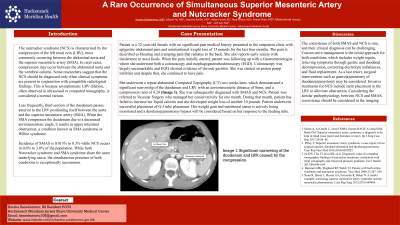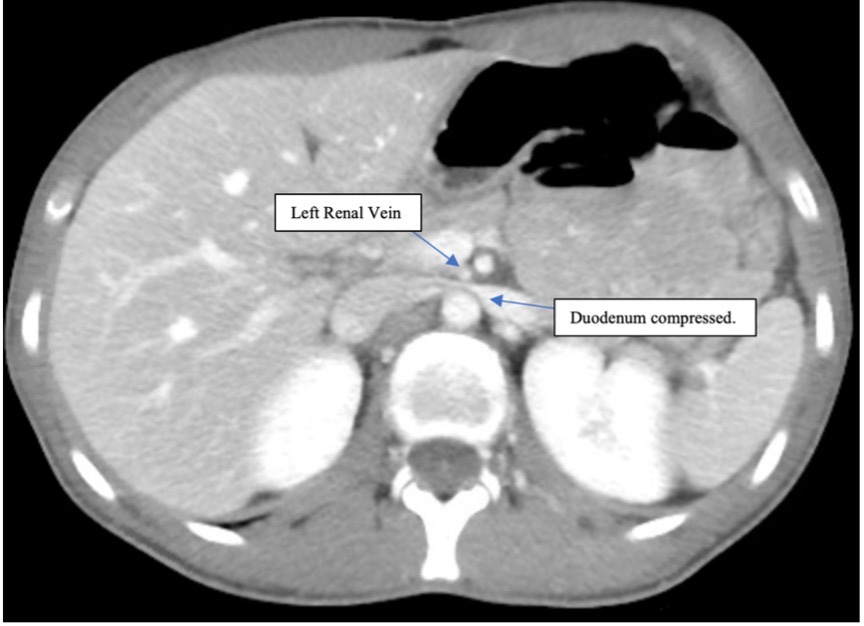Tuesday Poster Session
Category: Small Intestine
P4170 - A Rare Occurrence of Simultaneous Superior Mesenteric Artery Syndrome and Nutcracker Syndrome
Tuesday, October 24, 2023
10:30 AM - 4:00 PM PT
Location: Exhibit Hall

Has Audio

Harshavardhan Sanekommu, MD
Hackensack Meridian Jersey Shore University Medical Center
Neptune, NJ
Presenting Author(s)
Harshavardhan Sanekommu, MD1, Sobaan Taj, MD1, Jayasree Ravilla, MD2, Aidan Farrell, BS3, Rida Mah Noor, BS4, Muhammad Umair Akmal, BS5, Reza Akhtar, MD3, Mohammad Hossain, MD3, Arif Asif, MD, MBA, MAS3
1Hackensack Meridian Jersey Shore University Medical Center, Neptune, NJ; 2Monmouth Medical Center/RWJBH, Long Branch, NJ; 3Hackensack Meridian Jersey Shore University Medical Center, Neptune Township, NJ; 4International University of Kyrgyzstan, International School of Medicine, Bishkek, Bishkek, Kyrgyzstan; 5Kazakh National Medical University, Almaty, Almaty, Kazakhstan
Introduction: Nutcracker Syndrome (NCS) occurs when there is an outflow obstruction from the left renal vein (LRV) into the inferior vena cava (IVC) due to external compression of the LRV. Similarly, Superior Mesenteric Artery Syndrome (SMAS) arises when the third portion of the duodenum is compressed by the SMA leading to an obstruction of the duodenum. Incidence of SMAS is 0.013% to 0.3% while NCS occurs in 0.6% to 3.0% of the population. Concurrent development of both conditions is rare.
Case Description/Methods: Patient is a 32-year-old female with no significant past medical history presented to the outpatient clinic with epigastric abdominal pain and unintentional weight loss of 15 pounds for the last four months. The pain is described as bloating and cramping pain that radiates to the back. She also reports early satiety with intolerance to most foods. When the pain initially started, patient was following up with a Gastroenterologist where she underwent both a colonoscopy and esophagogastroduodenoscopy (EGD). Colonoscopy was largely unremarkable and EGD showed evidence of chronic gastritis. She was started on proton pump inhibitor and despite that, she continued to have pain. She underwent a repeat abdominal Computed Topography (CT) two weeks later, which demonstrated a significant narrowing of the duodenum and LRV with an aortomesenteric distance of 8mm, and a compression ratio of 4.29 (Image 1). She was subsequently diagnosed with SMAS and NCS. Patient was referred to Vascular Surgery who managed her conservatively for one month. During that month, patient has failed to increase her liquid calories and she developed weight loss of another 10 pounds. Patient underwent successful placement of G-J tube placement. Her weight gain and nutritional status is actively being monitored and a duodenojejunostomy bypass will be considered based on her response to the feeding tube.
Discussion: The coexistence of both SMAS and NCS is rare, and their clinical diagnosis can be challenging. Conservative management is the initial approach for both conditions, which includes weight regain, relieving symptoms through gastric and duodenal decompression, correcting electrolyte imbalances, and fluid replacement. As a last resort, surgical interventions such as gastrojejunostomy of duodenojejunostomy may be considered. Invasive treatments for NCS include stent placement in the LRV to alleviate obstruction. Considering the similar pathophysiology between NCS and SMAS, coexistence should be considered in the imaging.

Disclosures:
Harshavardhan Sanekommu, MD1, Sobaan Taj, MD1, Jayasree Ravilla, MD2, Aidan Farrell, BS3, Rida Mah Noor, BS4, Muhammad Umair Akmal, BS5, Reza Akhtar, MD3, Mohammad Hossain, MD3, Arif Asif, MD, MBA, MAS3. P4170 - A Rare Occurrence of Simultaneous Superior Mesenteric Artery Syndrome and Nutcracker Syndrome, ACG 2023 Annual Scientific Meeting Abstracts. Vancouver, BC, Canada: American College of Gastroenterology.
1Hackensack Meridian Jersey Shore University Medical Center, Neptune, NJ; 2Monmouth Medical Center/RWJBH, Long Branch, NJ; 3Hackensack Meridian Jersey Shore University Medical Center, Neptune Township, NJ; 4International University of Kyrgyzstan, International School of Medicine, Bishkek, Bishkek, Kyrgyzstan; 5Kazakh National Medical University, Almaty, Almaty, Kazakhstan
Introduction: Nutcracker Syndrome (NCS) occurs when there is an outflow obstruction from the left renal vein (LRV) into the inferior vena cava (IVC) due to external compression of the LRV. Similarly, Superior Mesenteric Artery Syndrome (SMAS) arises when the third portion of the duodenum is compressed by the SMA leading to an obstruction of the duodenum. Incidence of SMAS is 0.013% to 0.3% while NCS occurs in 0.6% to 3.0% of the population. Concurrent development of both conditions is rare.
Case Description/Methods: Patient is a 32-year-old female with no significant past medical history presented to the outpatient clinic with epigastric abdominal pain and unintentional weight loss of 15 pounds for the last four months. The pain is described as bloating and cramping pain that radiates to the back. She also reports early satiety with intolerance to most foods. When the pain initially started, patient was following up with a Gastroenterologist where she underwent both a colonoscopy and esophagogastroduodenoscopy (EGD). Colonoscopy was largely unremarkable and EGD showed evidence of chronic gastritis. She was started on proton pump inhibitor and despite that, she continued to have pain. She underwent a repeat abdominal Computed Topography (CT) two weeks later, which demonstrated a significant narrowing of the duodenum and LRV with an aortomesenteric distance of 8mm, and a compression ratio of 4.29 (Image 1). She was subsequently diagnosed with SMAS and NCS. Patient was referred to Vascular Surgery who managed her conservatively for one month. During that month, patient has failed to increase her liquid calories and she developed weight loss of another 10 pounds. Patient underwent successful placement of G-J tube placement. Her weight gain and nutritional status is actively being monitored and a duodenojejunostomy bypass will be considered based on her response to the feeding tube.
Discussion: The coexistence of both SMAS and NCS is rare, and their clinical diagnosis can be challenging. Conservative management is the initial approach for both conditions, which includes weight regain, relieving symptoms through gastric and duodenal decompression, correcting electrolyte imbalances, and fluid replacement. As a last resort, surgical interventions such as gastrojejunostomy of duodenojejunostomy may be considered. Invasive treatments for NCS include stent placement in the LRV to alleviate obstruction. Considering the similar pathophysiology between NCS and SMAS, coexistence should be considered in the imaging.

Figure: Figure shows the simultenous compression of the duodenum and left renal vein caused by the acute angle of the SMA branch from the abdominal aorta.
Disclosures:
Harshavardhan Sanekommu indicated no relevant financial relationships.
Sobaan Taj indicated no relevant financial relationships.
Jayasree Ravilla indicated no relevant financial relationships.
Aidan Farrell indicated no relevant financial relationships.
Rida Mah Noor indicated no relevant financial relationships.
Muhammad Umair Akmal indicated no relevant financial relationships.
Reza Akhtar indicated no relevant financial relationships.
Mohammad Hossain indicated no relevant financial relationships.
Arif Asif indicated no relevant financial relationships.
Harshavardhan Sanekommu, MD1, Sobaan Taj, MD1, Jayasree Ravilla, MD2, Aidan Farrell, BS3, Rida Mah Noor, BS4, Muhammad Umair Akmal, BS5, Reza Akhtar, MD3, Mohammad Hossain, MD3, Arif Asif, MD, MBA, MAS3. P4170 - A Rare Occurrence of Simultaneous Superior Mesenteric Artery Syndrome and Nutcracker Syndrome, ACG 2023 Annual Scientific Meeting Abstracts. Vancouver, BC, Canada: American College of Gastroenterology.
